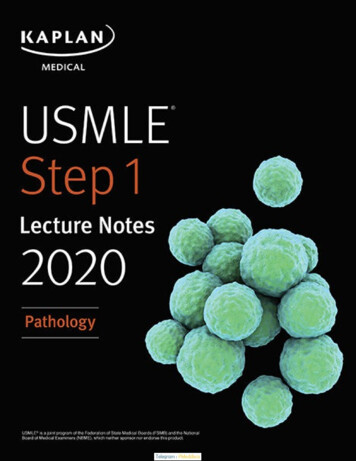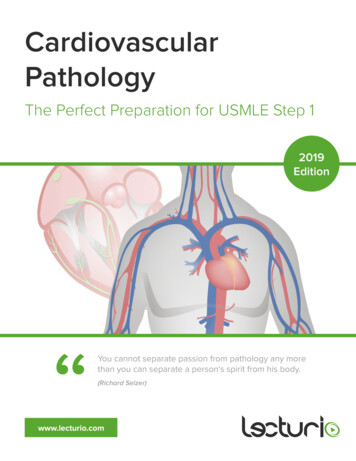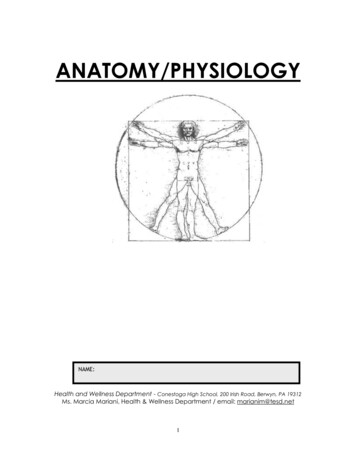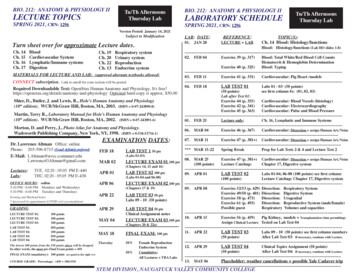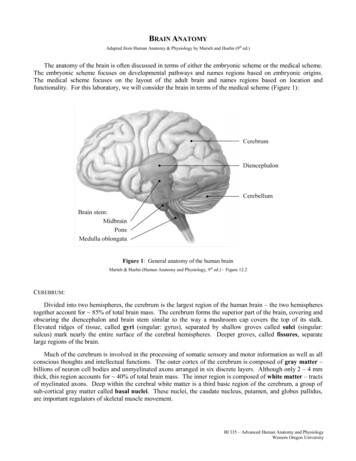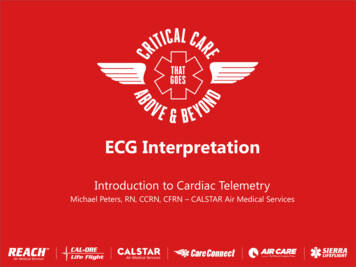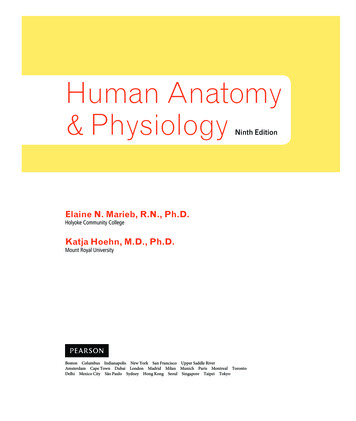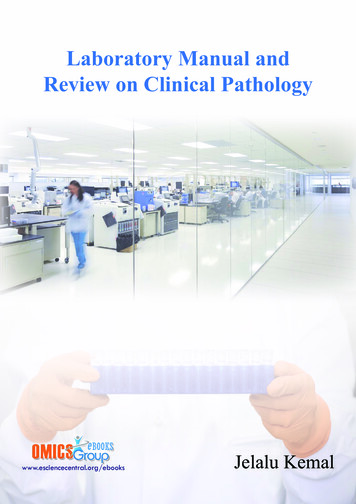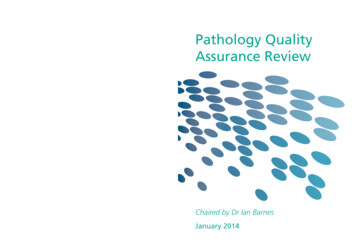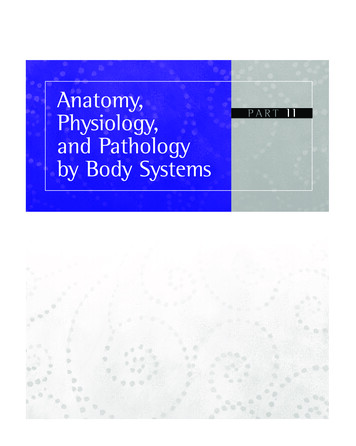
Transcription
Allen Ch03 023-032.qxd7/25/084:20 PMPage 23Anatomy,Physiology,and Pathologyby Body SystemsPART II
Allen Ch03 023-032.qxd7/25/084:20 PMPage 25An Overview ofAnatomy, Physiology,and PathologyGood work is not accomplished in haste.CHAPTER 3—Ancient Chinese ProverbHIGHLIGHTSLet’s begin with some basic definitions. Anatomy is the study of the structure of thebody. Physiology is the study of the functions of the body.Anatomy has many subdisciplines. Cytology is the microscopic study of the structure of cells. Histology is the study of tissue. Developmental anatomy is the study of thestructure from egg to adult form. Embryology is the study of structures from the time offertilization through the eighth week of gestation. Gross anatomy refers to structuresthat can be studied without the aid of a microscope. Pathological anatomy is the studyof changes in structures caused by disease. Regional anatomy is the study of a specificregion of the body, such as the head or lower extremities. Radiographic anatomy is thestudy of the body through x-rays. Surface anatomy is the study of the body throughobservation and palpation. Systemic anatomy is the study of specific body systems.The logical order for learning anatomy is to get to know the chemistry of the body,the body’s cellular structure, and the major systems of the body—their components,their location, and their functions. Massage students left on their own to study mayfocus on the muscles and bones, ignoring other systems, such as the urinary systemor the reproductive system. Don’t! Although it might be difficult to see why massagetherapists would need to know how the urinary system or the reproductive systemfunctions, it is on the test.Physiology also has subdisciplines. These subdisciplines include neurophysiology, the study of nerves; cell physiology, the study of cell function; and exercise physiology, the study of the acute responses and long-term adaptations of the body tophysical activity or exercise. In the study of any body system, whenever any structure25
Allen Ch03 023-032.qxd267/25/08PART II4:20 PMPage 26Anatomy, Physiology, and Pathology by Body Systemsis affected by a pathological condition, the physiology of the structure may be affectedas well; therefore, cardiology, endocrinology, and study of other body systems mayalso cross over into the categories of physiology and pathology. As mentioned, thisguide is not meant to be an anatomy text by anyone’s standards. To prepare adequately for your exam, you will want to review the anatomy and physiology textbookyou had in school, and be sure you can answer the questions in it.Another reason to know basic anatomy and physiology is for the benefit of yourfuture clients. Although massage therapists are not allowed to prescribe or diagnose,part of your process is to take a thorough health history of clients before you beginthe massage session. The more knowledge you have, the more competent you appearto the client. In my experience, clients often discuss their health problems while theyare on the table; some will even ask you questions in the same way they would ask adoctor. Avoid giving unqualified advice. However, if a client asks where the spleen islocated or what function it performs, you should be able to answer that question.Part of your task as a massage therapist is to educate clients within the scope ofpractice and your own areas of expertise. By offering clients a holistic education thatemphasizes the interconnections and integration of theory and practice, you areempowering them and furthering your own goals of creating a successful practice.Because you have gotten this far in your quest to become a massage therapist,think back to the time before studying any anatomy, and see how much more bodyawareness you have now than you did before undertaking your massage studies. If youfeel a sharp pain somewhere, can you identify its location? Do not diagnose yourself,either; if you are sick, seek help. The point is that it is useful to know where your owngallbladder or Achilles tendon is located. Your own body awareness is vital to yourability to function optimally as a massage therapist. Practicing good body mechanicsand ergonomics can extend your career by years. Conversely, working in the wrongway can shorten your career by years! Many therapists have had their careers cutshort by hyperextended thumbs, carpal tunnel syndrome, or back pain from workinghard instead of working smart.The examination includes kinesiology, the study of movement; this guide coverskinesiology in Chapter 20.An Overview of the Human BodyThe basic unit of life is the cell. Groups of similar cells combine to form tissue. Tissuetypes are defined in their respective sections of the body systems in which they occur.A collection of tissues having a specific function is an organ. Organs acting together toperform specific functions are called organ systems, which in turn make up the body,also called an organism. The organs of the body reside in cavities that are named forthe organs or regions in which the organs are housed. The abdominal cavity holds thedigestive organs and the liver and spleen. The abdominopelvic cavity describes boththe abdominal cavity below the diaphragm and the pelvic cavity, which houses theurinary bladder, the rectum, and the internal reproductive organs. The thoracic cavityis protected by the rib cage and contains the vital organs, such as the heart and lungs.The pericardial cavity is the specific cavity within the thoracic cavity that protectsthe heart. The term ventral cavity describes the combined thoracic andabdominopelvic cavities. The interconnected cranial cavity, which houses the brain,and the spinal cavity, which houses the spinal cord, is described as the dorsal cavity.The 11 body systems of the human organism are the integumentary system, theskeletal system, the muscular system, the nervous system, the cardiovascular system,the lymphatic system, the respiratory system, the digestive system, the endocrine system, the urinary system, and the reproductive system. In addition, the sensory system
Allen Ch03 023-032.qxd7/25/084:20 PMPage 27CHAPTER 3An Overview of Anatomy, Physiology, and Pathology27is contained within several of the other systems. The sense of taste, for example, is partof the digestive system and the nervous system; the sense of touch is part of the integumentary system and the nervous system. The craniosacral system is often referred toas a separate system, but it is actually part of the nervous system. These systems, aswell as the chemistry and cellular structure of the body, are discussed in the chaptersthat follow. For the examination, you will be expected to know the organs, the location,and the functions of all the systems, which are summarized in Table 3.1. For clarity andconvenience when studying, at the end of each body system chapter, the pathology ofthat particular system is reviewed.T A B L E 3.1Body SystemsSystemComponentsFunctionsIntegumentarySkin and associated structures such as hair, nails,sweat glands, and oil glandsProtects body; helps regulate body temperature, wasteelimination, production of vitamin D; detects sensationssuch as hot, cold, pain, etc.SkeletalBones and joints and associated cartilagesSupports and protects body; aids movements, houses cells thatgive rise to blood cells, stores minerals and fatsMuscularSkeletal muscle tissue, usually attached to bonesProduces body movements, stabilizes posture, produces body heatNervousBrain, spinal cord, nervesRegulates body activities through nerve impulses by detectingchanges in body’s internal and/or external environment andreacting by causing muscle contractions or glandular secretionsCardiovascularBlood, heart, blood vesselsCarries oxygen and nutrients to cells and carbon dioxide andother wastes away from cells; helps regulate acidity,temperature, and water content in bodily fluids; bloodcomponents aid immunity and repair of damaged blood vesselsLymphaticLymphatic fluid and vessels; also structures thatcontain lymphocytes (white blood cells), such asspleen, lymph nodes, thymus gland, and tonsilsProtects against disease-causing organisms; returns proteinsand other substances to blood and carries lipids from GI tractto bloodRespiratoryLungs and the airways going into and out of themTransfers oxygen from inhaled air to the blood and carbondioxide from blood to exhaled air; helps regulate pH of bodyfluids; allows vocal cords to produce sound through airflowing out of lungsDigestiveGI tract, starting at mouth and includes esophagus,stomach, intestines, and ends at anus; also includesorgans that aid digestion, such as salivary glands,liver, pancreas, and gallbladderAbsorption of nutrients by physical and chemical breakdownof food and elimination of wasteEndocrineCells and glands that produce hormones: pancreas,thyroid, pituitary, adrenal, and pineal glandsRegulates body activities through release of hormonesUrinaryKidneys, ureters, urinary bladder, and urethraProduces, stores, and eliminates waste products through urine;regulates blood volume, composition, and mineral balance;aids in red blood cell productionReproductiveGonads (testes or ovaries) and associated organs; infemales, uterine tubes, uterus, and vagina; in males,epididymis, ductus deferens, prostate gland, andpenisProduces gametes in gonads for reproduction; regulatesreproduction and other processes through release of hormones
Allen Ch03 023-032.qxd287/25/084:20 PMPage 28PART IIAnatomy, Physiology, and Pathology by Body e(horizontal)planeFIGURE 3.1Planes of the body.(Reprinted with permission from Cohen BJ, Wood DL. Memmler’s The Human Body in Health and Disease,10th ed. Philadelphia: Lippincott Williams & Wilkins; 2005.)Directional TerminologyWhile studying the human body, it is vital to know directional terminology. The bodycan be described by planes of division (Fig. 3.1). The frontal plane divides the bodyinto anterior and posterior positions. The frontal plane is also called the coronal plane.The sagittal plane divides the body into left and right sections; the midsagittal planedivides the body into equal left and right sections. The transverse plane, which dividesthe body into upper and lower sections, is also called the horizontal plane. The bodyis also described using anatomical directions as points of reference, as listed.Anatomical position: standing erect, facing forward, arms at side, palms facingforwardAnterior (ventral): toward the front; in front ofCaudal (inferior): toward the tail; lowerCephalad: toward the head; upperCranial (superior): toward the headDeep: far from the surfaceDistal: away from a point of reference; farthest from the trunkDorsal (posterior): toward the back; in back ofInferior (caudal): toward the tail; lowerLateral: away from the midline of the bodyMedial: toward the midline of the bodyPosterior (dorsal): toward the back; in back ofProximal: toward or nearest the trunk or point of referenceSuperficial: near the surface
Allen Ch03 023-032.qxd7/25/084:20 PMPage 29An Overview of Anatomy, Physiology, and PathologySuperior (cranial): toward the headVentral (anterior): toward the front; in front ofPATHOLOGY: THE STUDY OF DISEASEDisease can be defined as an impairment of health that interferes with the body’s ability to function normally. Injuries, poisonings, the introduction of foreign substances,and environmental problems do not strictly fall into the category of disease but theycause their own pathologies nonetheless.As mentioned, each body system chapter contains its own section on pathology.But here we will review some general terminology associated with disease and injury.Let us start by looking at the roots of the word pathology. The suffix –ology means thestudy of, and the prefix path– means feeling or suffering, from the Greek pathos, meaning disease. There are two main types of pathology. Anatomical pathology focuses onthe study of tissues removed from a dead or living person to diagnose disease or causeof death. Clinical pathology is actually a number of subdisciplines that are oftenreferred to as laboratory medicine: chemistry, histology, microbiology, and other specialties. To go even further, pathophysiology is the study of how disease and traumaalter the normal functioning of the body.To know what is abnormal, you must first know what is normal—not just regarding disease but also regarding simple body function. You may encounter questions onthe test pertaining to normal blood pressure, normal body temperature, normal bloodpH, and so on.WHAT YOU NEED TO KNOWAcute: characterized by sudden onsetAerobe: an organism that lives in an oxygen environmentAmbulatory: able to walkAnaerobe: an organism that lives in an oxygen-free environmentAnaplasia: the irregular structural characteristics of a cell that identify it as a malignant cancer cellAnomaly: an abnormal occurrence, especially in reference to birth defectsAntibiotic: a chemical substance derivable from a mold or bacterium that killsmicroorganisms and cures infectionsAntibody: a protein produced by the body as part of its defense against foreignbacteria or blood cellsAntisepsis: the prevention of sepsis by excluding or destroying microorganismsAntiseptic: a substance that kills or prohibits the growth of microorganismsAsepsis: free from germsAtrophy: a wasting away or decrease in size of a cell, tissue, organ, or part of thebody caused by lack of nourishment, inactivity, or loss of nerve supplyAutoimmunity: a situation in which the body produces an immune response againstits own organs or tissues, causing severe inflammation and chronic conditionsBacteria: microorganisms capable of reproduction; some strains cause infection(and some are beneficial)CHAPTER 329
Allen Ch03 023-032.qxd307/25/084:20 PMPage 30PART IIAnatomy, Physiology, and Pathology by Body SystemsBenign: referring to a tumor, or abnormal growth, that is not cancerous and does notinvade nearby tissues or spread to other parts of the bodyChronic: slow developing, recurringDegenerative: characterized by diminishing capabilitiesDiagnosis: the identification of disease or traumaDisease: an impairment of health that interferes with the body’s ability to functionnormallyDisinfect: the prevention of sepsis by excluding or destroying microorganismsEndemic: characterizing a disease that exists in a location or group of people all thetimeEpidemic: a sudden outbreak of disease in numbers much higher than normalEtiology: the study of the cause and origin of diseaseExacerbation: a marked increase in symptoms or severity of diseaseFungus: a mold, yeast, or mushroom; some fungi are beneficial; some, such as ringworm and athlete’s foot, are not.Hereditary: genetically passed from parent to childHyperplasia: an increase in the number of cells in an organ or tissueIdiopathic: of unknown originInfection: the invasion and growth of microorganisms that may cause cellular injuryin tissueInflammation: a protective response from the body in response to infection or injury,characterized by swelling, heat, redness, and painLocal: affecting only one partMalignant: cancerous; a growth with a tendency to invade and destroy nearby tissueand spread to other parts of the bodyMorbid: diseased or sickMorbidity: any departure, subjective or objective, from a state of physiological orpsychological well-beingNeoplasm: an abnormal growth of tissue that may be benign or malignantPandemic: an epidemic that affects an expanded demographic areaPathogenesis: the origin and development of diseasePathology: the study of diseasePathophysiology: the study of how disease and/or trauma alters the normal functioning of the bodySigns: the evidence of disease as perceived by the doctorSterilize: to destroy bacteria and other microorganismsSymptoms: the subjective evidence of disease as perceived by the patientSyndrome: a group of signs or symptoms characteristic of a particular disease orabnormal conditionSystemic: affecting the whole bodyTrauma: a physical injury or wound caused by an external force of violence, whichmay cause death or permanent disability. Trauma is also used to describe severeemotional or psychological shock or distress.Virulence: the ability of an organism to cause diseaseVirus: an intracellular parasite that causes disease
Allen Ch03 023-032.qxd7/25/084:20 PMPage 31An Overview of Anatomy, Physiology, and PathologyT I P SF O RCHAPTER 331P A S S I N GA full-length mirror is one of the most useful reference tools in studying for the examination. Stand in front of the mirror and draw the planes and directions in the air untilyou have them memorized. As you go through the next chapters, do the same for thebones and muscles. Touch them and say the names out loud several times.AffirmationI persevere and finish anytask that I undertake.Practice Questions1. The basic unit of life is the .a. Atomb. Cellc. Moleculed. Organelle2. The study of the structure of the body is called .a. Kinesiologyb. Neurobiologyc. Pathologyd. Anatomy3. Cephalad means .a. Toward the feetb. In the middle of the torsoc. Toward the headd. Toward the pelvis4. Antibodies are molecules of involved in the immune response of the body.a. Carbohydratesb. Lipidsc. Antibioticsd. Proteins5. Etiology is the study of .a. The cause of diseaseb. The sex organsc. Insectsd. Emotions6. The condition characterized by swelling, heat, redness, and pain is known as.a. Chicken poxb. Fibromyalgiac. Cushing syndromed. Inflammation7. In the Western anatomical position, the human body is: .a. Standing erect, facing forward, arms at side, palms facing forwardb. Standing erect, facing forward, arms straight out, palms facing forwardc. Standing erect, facing forward, arms at side, palms facing backwardd. Standing erect, facing forward, arms bent at elbow, palms facing up
Allen Ch03 023-032.qxd327/25/08PART II4:20 PMPage 32Anatomy, Physiology, and Pathology by Body Systems8. The pericardial cavity is located within the .a. Abdominopelvic cavityb. Cranial cavityc. Spinal cavityd. Thoracic cavity9. The study of the tissues of the body is referred to as .a. Histologyb. Phrenologyc. Molecular biologyd. Physiology10. A short, severe episode is referred to as .a. Chronicb. Acutec. Terminald. Minute11. The ability of an organism to cause disease is referred to as .a. Hyperplasiab. Pandemicc. Virulenced. Asepsis12. The human body is an .a. Anaerobeb. Organismc. Organ systemd. Anomaly13. The increase in symptoms or severity of a condition is a(n) .a. Endemicb. Inflammationc. Exacerbationd. Malignancy14. The plane divides the body into upper and lower sections.a. Transverseb. Frontalc. Coronald. Sagittal15. A disease of unknown origin is referred to as .a. Idiopathicb. Pandemicc. Ideologicd. Epidemic
As mentioned, each body system chapter contains its own section on pathology. But here we will review some general terminology associated with disease and injury. Let us start by looking at the roots of the word pathology. The suffix –ology means the study of, and the prefix path– means
